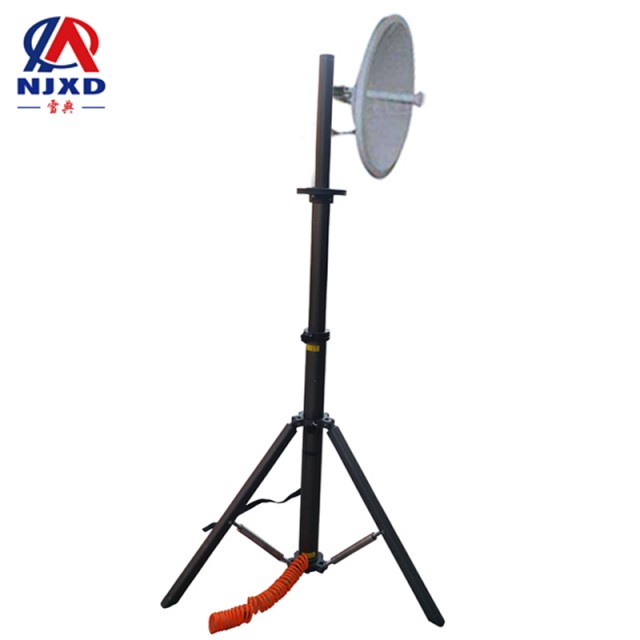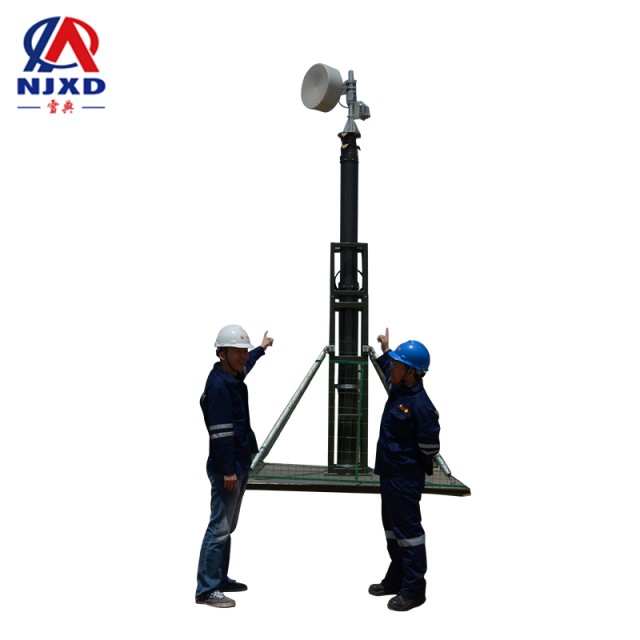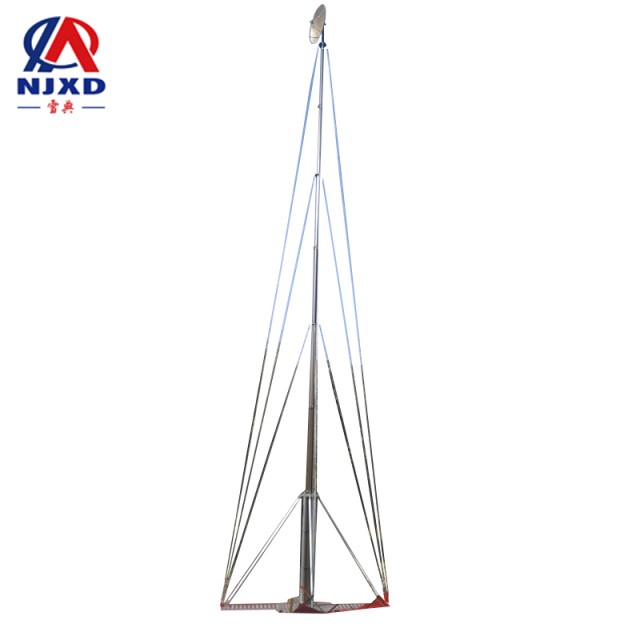NEWS
Main types of antenna telescopic mast microwave communication
Time:2021-07-16 View:

Main types
According to the difference between the communication mode and the transmission medium that determines the main properties of the channel, microwave communication can be divided into atmospheric sight distance ground microwave communication, tropopause over-sight distance scattering communication, satellite communication through ionosphere and outer free space, and space communtication mainly spread in free space. According to the different forms of baseband signals, microwave communication can be divided into analog microwave communication mainly used for transmitting multi-carrier telephones, carrier telegrams, television programs, etc., and mainly used for transmitting multi-channel digital telephones, high-speed data, digital microwave communication of digital TV, video conference and other new telecommunication services.
Microwave relay communication
Using microwave sight distance propagation to communicate with microwave in the relay mode of relay station, also known as microwave relay communication. The microwave relay system consists of terminal stations at both ends and several relay stations in the middle, which are point-to-point communication of ground sight distance. Balanced configuration of transceiver equipment of each station, station distance is about 50km, antenna diameter is 1.5~4m, half power angle is 3~5 °, transmitter power is 1~10W, receiver Noise coefficient 3 ~ 10dB (equivalent noise temperature 290~261K), if necessary, double diversity reception. The capacity of analog frequency modulation microwave can reach 1800~2700 channels, and the capacity of digital multi-ary orthogonal amplitude modulation microwave can reach 144Mbit/s. The equipment investment and construction cost are less, and the maintenance is convenient; The engineering construction and equipment installation cycle are shorter, and the communication circuit can be repaired quickly by using the vehicle-mounted microwave station.
Stratosphere scattering communication
The over-the-horizon wireless communication is realized by using the scattering effect of the discontinuous interface of the heterogeneous medium in the tropopause on the microwave. The common frequency band is 0.2~5GHz, which is ground over-the-horizon point-to-point communication. Span hundreds of kilometers, large billboard (parabolic) antenna equivalent diameter can reach 30~35m, beam half power angle 1~2 °, aperture dielectric coupling loss, transmitter power 5 ~ 50kW, quadruple diversity reception, with a capacity of dozens of calls to more than 100 calls. Tropopause scattering communication is generally not affected by solar activity and nuclear explosion, and communication circuits can be established in mountainous areas, hills, deserts, marshes, Gulf Islands and other regions.
Satellite communication
The earth stations use the radio communication of repeater forwarding signals on artificial earth satellites. For the Earth-space line-of-sight multiple access communication system, satellite relay stations are limited by energy and heat dissipation conditions, old-empty devices are heavily configured. Synchronous satellite system, the space section one-way is more than 36,000 kilometers, the ground station antenna diameter is 15 ~ M, the gain is 60dB, the beam half power angle is 0.1~1 °, and automatic tracking is required, transmitter power 0.5 ~ 5kW.
Satellite relay station, the downlink global beam uses horn antenna, and the spot beam uses parabolic antenna, which can be used for frequency reuse by beam separation. The power of repeater is tens of Watts, the bandwidth is generally 36MHz, and the capacity is 5000~10000. Satellite communication has a wide coverage and extended time, and signals are easily intercepted, eavesdropped, and even interfered. A small capacity very small antenna Earth station (VSAT) suitable for sparse routing is suitable for data communication.
Space communtication
Communication between stars (including satellites, spacecraft and other spacecraft) by using microwaves. It includes the communication between the Earth station and the spacecraft, the communication between the spacecraft and the spacecraft, and the satellite communication transmitted between the Earth stations through satellites. The communication between Earth station and spacecraft is divided into near-space communication and deep-space communication. In deep space communication, in order to extract weak signals from high noise background, special coding and modulation, coherent reception, bandwidth compression and other technologies need to be adopted.
Microwave mobile communication
The microwave communication between the two parties or one party in motion is divided into three types of mobile communication: land, sea and aviation. Land-based mobile communication mostly uses 150,450 or 900MHz frequency bands and is developing towards higher frequency bands. Satellite communication can be used for maritime, aviation and land mobile communication. Maritime satellites can provide such mobile communication services. Low Earth Orbit (LEO) light satellites will be widely used in mobile communication services.

Anti-fading technology
Microwave transmission will also decline due to the interference of many external factors. Sometimes the duration of fading is very short, in a few seconds to a few minutes, it is called fast fading, sometimes the duration of fading lasts for more than ten minutes or even several hours, it is called slow fading. In fading, receiving level higher than normal level is called up fading, and lower than normal level is called down fading. When fading, the receiving level is lower than the lowest receiving level of the receiver, hereinafter referred to as deep fading. The influence of space fading phenomenon on microwave communication mainly has two aspects: one is the decrease of reception level, which is called flat fading; The other is the distortion of transmission waveform caused by the frequency selectivity of fading, it is called frequency selective fading.
Absorption fading
Oxygen molecules and moisture molecules in the atmosphere can absorb energy from electromagnetic waves, resulting in energy loss and decay in the process of microwave propagation. The higher the frequency, the longer the station distance, the more serious the fading.
Scattering fading
Large and small water droplets in rain and fog can scatter the energy of electromagnetic waves, thus causing the energy loss of electromagnetic waves and causing fading. In rainy and foggy weather, it has great influence on high frequency microwave.
K-type fading
Interference fading caused by multi-path transmission. Because this kind of fading changes with the change of K value of atmospheric refraction parameter, it is called K-type fading. This kind of decline is especially serious when water surface, Lake and smooth ground.
Waveguide type fading
Due to the influence of meteorology, uneven atmospheric waveguide will be formed in the atmosphere. If microwave rays pass through the atmospheric waveguide, acceptance point of the electric field strength contains reflected waves other than the waveguide layer, resulting in serious interference fading, causing communication interruption.
Flicker fading
Atmospheric turbulence often occurs in the atmosphere in the stratosphere, and the uneven block layer formed by atmospheric turbulence makes the dielectric coefficient different from the surrounding. When microwave rays are emitted to uneven block layers, the radio waves will radiate to the surroundings, forming the scattering of the tropopause. At this time, acceptance point can also receive this scattering wave from multiple paths, forming fast fading. Because this kind of fading is caused by multi-path, it is called flicker fading.
The technologies against these fading include adaptive equalization, automatic transmission power control (ATPC), forward error correction (FEC) and diversity reception.
Microwave anti-fading technology
Anti-fading technology
Adversarial effect
Adaptive equalization
Waveform distortion
Automatic sending power control (ATPC)
Power reduction
Forward error correction (FEC)
Power reduction
Diversity receiving technology
Power reduction and waveform distortion

New technology
Adaptive modulation and coding (AMC) is widely used in mobile communication. The coding rate is adjusted according to the channel quality to obtain higher throughput. When the wireless communication rate is relatively low, the channel estimation is relatively accurate, and the application effect of AMC is better.
With the continuous acceleration of terminal movement speed, the channel quality can no longer meet the channel changes. In the case of channel measurement errors, AMC modulation and coding methods are different from the actual situation, it affects the system capacity, throughput and other performance indicators, and is worthy of in-depth study by relevant personnel.
Wireless communication technology contains two basic technologies, namely transmission technology and multiple access technology. Wi MAX uses the OFDM modulation technology as the basic transmission technology. The OFDM modulation technology passes the data stream in the state of high-speed propagation, then converts the data, and distributes the converted data to multiple orthogonal subchannels with low transmission rate, complete the transfer process.
As for multiple access technology, OFDMA technology is selected in Wi MAX. The method used by OFDMA technology is Frequency Division Multiple Access. Compared with OFDM, this technology has the following advantages: the allocation method is more flexible and the same frequency band can realize the transportation of multiple heat sources. All users in OFDMA can choose a sub-channel with good conditions as the channel for data transmission to complete data transmission. However, the OFDM technology needs to use the entire frequency band to transmit data.

CATEGORY
NEWS
- Main Features and technical principles of microwave lifting communication
- Main types of antenna telescopic mast microwave communication
- Scattering communication of lifting antenna bracket
- Emergency Communication Command car infrared communication lifting
- Classification and application of lifting tower radio stations